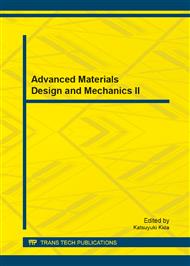p.612
p.620
p.630
p.635
p.641
p.646
p.650
p.657
p.661
FEM-Based Simulation and Gripper Jaw Trajectory Fitting of Stretch-Bending Process for a Bending Beam of Railway Vehicles
Abstract:
The bending beam of railway vehicle is made of thin stainless steel, with large sizes and unsymmetrical section, and prone to defects during stretch-bending forming process, such as wrinkling, cross-section distortion and so on. A reasonable trajectory of gripper jaws could make for mitigating the mentioned defects. The Finite Element Method was employed to fit the trajectory as well as simulate the forming process. The FE model was built by using the commercial FE software Hypermesh and ABAQUS/CAE. The analysis was carried out based on dynamic explicit and displacement control method. On this basis, the actual stretch bending process was developed according to the fitted trajectory and simulated process. The actual production process indicates that the formed beam can meet the design requirements, and the method is feasible and economical, as well as can contribute to a better understanding of stretch bending process and die design.
Info:
Periodical:
Pages:
661-665
Citation:
Online since:
August 2013
Authors:
Keywords:
Price:
Сopyright:
© 2013 Trans Tech Publications Ltd. All Rights Reserved
Share:
Citation:


